The robotic spacecraft will first orbit the asteroid before making a close approach in order to use a mechanical arm to collect dust from its surface.

The Lunar Exploration and Space Program Center of the China National Space Administration has reported that the Chinese government has approved a plan to send a robotic spacecraft to gather samples from an asteroid.
The 2016 HO3, the smallest and closest “quasi-satellite,” will be the target of the Tianwen 2 mission, which will send up a probe to collect samples from it and return them to Earth.
The main body of the craft will continue to travel towards a main-belt comet after completing this task in order to explore it, the centre said on Thursday in a notice inviting scientists to a workshop on this mission.
Researchers from the Chinese mainland, the special administrative regions of Hong Kong and Macao, as well as Taiwan, are invited to the workshop, which is scheduled to take place in Hefei, Anhui Province, on April 27 and 28. The Tianwen 2’s fundamental design, scientific objectives, mission payloads, operational patterns, and updates on asteroid studies will be the main topics, the centre noted.
The fundamental concept of the asteroid mission, according to Ye Peijian, a top spacecraft researcher at the China Academy of Space Technology, is to launch a large carrier rocket towards the 2016 HO3 with a probe made up of two parts: an orbiter and a reentry module.
The robotic spacecraft will first orbit the asteroid before making a close approach in order to use a mechanical arm to collect dust from its surface. The probe will return to Earth’s orbit with the samples on board, separate its reentry module, and fall back to the planet’s surface.
The orbiter will then proceed with its scientific exploration tasks by heading towards main belt comet 311P, he said. About 1 million asteroids have been found by scientists in our solar system, and more than 20,000 of them are currently approaching Earth.
Asteroid survey telescopes at the Haleakala Observatory in Hawaii made the initial discovery of 2016 HO3, also known as 469219 Kamo’oalewa, in April 2016.
The celestial body follows Earth’s orbit as it moves in an orbit around the sun. Although it is too far away to be regarded as a true satellite of Earth, according to NASA experts, it is the best and most stable example of a near-Earth companion, or quasi-satellite, to date.
China’s first independent interplanetary exploration mission, Tianwen 1, covered more than 470 million kilometres before succeeding in putting the Zhurong rover on Mars in May 2021. On the Red Planet, the rover has already covered nearly 2,000 metres and gathered a tonne of raw data.